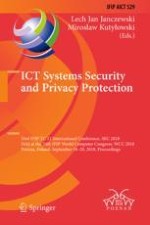2018 | Book
ICT Systems Security and Privacy Protection
33rd IFIP TC 11 International Conference, SEC 2018, Held at the 24th IFIP World Computer Congress, WCC 2018, Poznan, Poland, September 18-20, 2018, Proceedings
Editors: Lech Jan Janczewski, Mirosław Kutyłowski
Publisher: Springer International Publishing
Book Series : IFIP Advances in Information and Communication Technology
